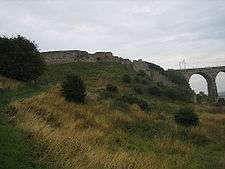Berwick Castle
| Berwick Castle | |
|---|---|
| Berwick-upon-Tweed, Northumberland, England | |
|
Motte and keep wall of Berwick Castle, with the rail bridge to the right | |
 Berwick Castle | |
| Coordinates | grid reference NT992535 |
| Type | Motte and bailey |
| Site information | |
| Owner | English Heritage |
| Open to the public | Yes |
| Condition | Ruined |
| Site history | |
| Materials | Stone |
| Events | Wars of Scottish Independence |
Berwick Castle is a ruined castle in Berwick-upon-Tweed, Northumberland, England.
History
The castle was founded in the 12th century by the Scottish King David I. In 1296-8, the English King Edward I had the castle rebuilt and the town fortified, before it was returned to Scotland. In November 1292, King Edward announced in the Great Hall before the full parliament of England and many of the Nobility of Scotland his adjudication in favour of John Balliol of the dispute between him, Robert the Bruce and the count of Holland for the Crown of Scotland. 1330 "Domino Roberto de Lawedre" of The Bass, described as Custodian or Keeper of the Marches and the Castle of Berwick-upon-Tweed, received, apparently upon the termination of his employment there, £33.6s.8d, plus a similar amount, from the Scottish Exchequer.[1] The town and castle changed hands several times during the English-Scottish conflicts.
In 1464 the Exchequer Rolls of Scotland record that Robert Lauder of Edrington was paid £20 for repairs made to Berwick Castle. In the 16th century, during the reign of Elizabeth I, the walls were strengthened with the addition of two semi-circular artillery flanking towers, one at the river's edge and the other on the angle of the curtain wall.

The castle's location in the hotly disputed border country between England and Scotland made it one of the most important strongholds in the British Isles, and it enjoyed an eventful history. As a major tactical objective in the region, the castle was captured by both the English and Scots on a number of occasions and frequently sustained substantial damage; Edward I used it as his headquarters during the course of his invasions of Scotland. The castle also changed hands in less violent circumstances when the English King Richard I sold the castle to the Scots, to help fund the Third Crusade. The castle finally fell into English hands in the last week of August 1482. After invading Scotland following a pact with the Duke of Albany, Richard, Duke of Gloucester captured the castle from Patrick Hepburn, Lord Hailes.
The construction of modern ramparts around Berwick in the sixteenth century rendered the castle obsolete and its later history is one of steady decline. Large parts of the structure were simply used as a quarry (notably for the construction during the Commonwealth of the parish church, Holy Trinity, while in the nineteenth century, the Great hall and much of what remained was demolished to make way for Berwick-upon-Tweed railway station. The railway platforms now stand where King Edward took oaths of allegiance from Scottish nobility in 1296, marked by a large notice to that effect.
The principal surviving part of the structure is the late thirteenth century White Wall and the steep and long flight of steps known as the Breakneck Stairs. It is now administered by English Heritage.
Governors, or Keepers, of the castle
- Sir William Douglas, 1294–1296 surrendered to Edward I of England following the Massacre of Berwick
- Maurice de Berkeley, 2nd Baron Berkeley, English governor c.1314
- Edmond de Caillou, Gascon governor for the English, Killed at the Battle of Skaithmuir 1316.
- Sir Robert Lauder of The Bass, to circa 1330.
- Robert Lauder of Edrington (later Robert Lauder of The Bass), 1461/2-1474.
- David, Earl of Crawford, 1474–1478.
- Sir Robert Lauder of Edrington, Knt., 1478–1482.
- Sir Patrick Hepburn, 1st Lord Hailes, 1482 (last Scottish governor).
- Sir William Drury (d.1579), Marshal of Berwick-upon-Tweed, before 1564.
- Francis Russell, 2nd Earl of Bedford, appointed 1564
- Sir George Bowes of Streatlam, co.Durham (d.1580), Marshal of Berwick. In 1568 he escorted Mary, Queen of Scots, from Carlisle to Bolton Castle. His sister Margery married John Knox.

Notes
- ↑ Stuart, John, LL.D., and Burnett, George, Lord Lyon King of Arms, The Exchequer Rolls of Scotland, vol. 1, 1264–1359, Edinburgh, 1878, pp. 279,313,339
References
- Images of Berwick upon Tweed Castle
- Berwick Castle
- The David & Charles Book of Castles, by Plantagenet Somerset Fry, David & Charles, 1980. ISBN 0-7153-7976-3
- The History of Scotland, by John Hill Burton, Edinburgh, 1874: vols: iv. p.364-5, v. pps: 68, 71, 73, 115, 120, 257, and 365, for Sir William Drury
- John Knox, by Lord Eustace Percy, London, 1937, p.165.
External links
| Wikimedia Commons has media related to Berwick Castle. |
Coordinates: 55°46′26″N 2°00′42″W / 55.7738°N 2.0116°W

